
The 5 Best Palm Routers for Beginners and Pros
Anders Lindsborg
May 10, 2023 • 18 min reading time
Table of contents
Discover the Benefits of Hand Held Routers
What is a Hand Held wood Router?
Anatomy of a Hand Held Router
Selecting the Right Router Bit
Attaching Router Bits
Conventional Vs Climbing Cut
Creating Edge Profiles
Using a Router Fence
Surface Planing With Router – Setup
The 5 Best Palm Routers for Beginners and Pros
Bosch Colt Variable-Speed Palm Router Kit – GKF125CEPK
Bosch PR20EVS Router Tool
DeWalt 20V Max XR Cordless Palm Router
Makita RT0701C 1-1/4 HP Compact Palm Router
Bosch 12V Max EC Brushless Palm Edge Router
Summary
Discover the Benefits of Hand Held Routers
For woodworkers, a handheld router is an invaluable tool. Whether you are looking for a basic machine to get started with your projects or a more sophisticated tool for detailed work, choosing the right hand held router can be a daunting task.
This article will explore the various types of palm routers available and what they offer, from the Bosch Colt Variable-Speed Palm Router Kit to the Makita RT0701C 1-1/4 HP Compact Palm Router. You’ll learn about the anatomy of hand held routers, how to select the correct router bit, how to create edge profiles and surface planing, how to use a router fence, and the advantages and disadvantages of conventional vs climbing cuts.
Whether you’re a beginner or a pro, this guide will help you to find the perfect tools for the job.
Short Summary
- Hand Held Routers are versatile power tools used for shaping, trimming and crafting materials.
- Selecting the correct router bit with the appropriate shank size and bearing location is essential for obtaining desired results when using a router.
- The 6 best palm routers for beginners and pros offer a variety of features and benefits, including adjustable speed and bit depth, LED lights and ergonomic designs.
What is a Hand Held wood Router?
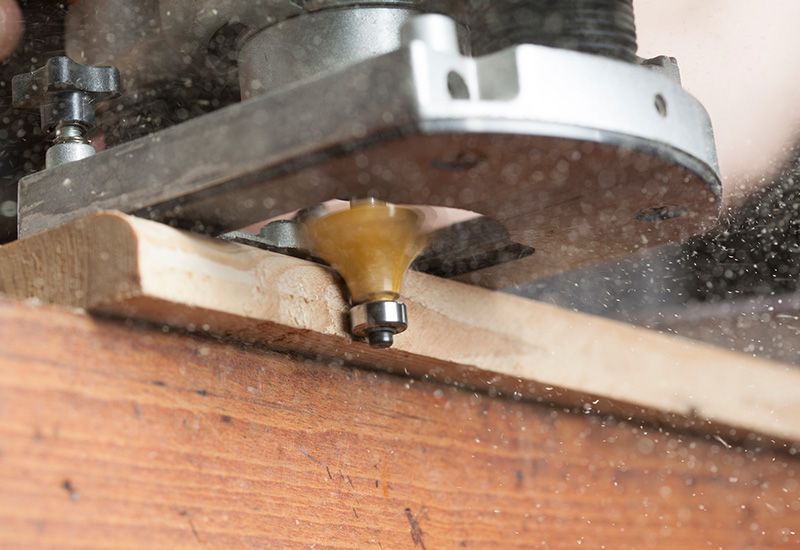
A hand held wood router is a type of power tool that is used to shape, trim, and craft materials for construction and design projects. It is a highly versatile tool that can be used to create edge profiles, square wood edges, and level uneven wood. When using a handheld router, it is essential to exercise extreme caution due to the sharp router bits spinning at high speeds, which can pose a significant safety hazard. For this reason, it is imperative to keep your hands away from the blade during operation.
In addition to shaping and trimming wood, a hand held router can be employed for a variety of tasks, such as cutting grooves, forming joints, and producing decorative finishes. Hand held routers are especially appreciated by DIYers and professionals alike, due to their portability and ease of use, making them an invaluable tool for completing a variety of jobs.
With the right router bits, a hand held router can be used for a variety of projects, such as trimming, shaping, and molding. From plunge routers and trim routers to palm routers and cordless routers, there is a wide selection of hand held routers available to suit any project.
Anatomy of a Hand Held Router

Hand held routers typically feature a flat surface for referencing your work, a depth adjustment mechanism, and require wrenches to loosen the collet that secures the router bit. These routers come in two distinct types: fixed and plunge. Fixed routers maintain a constant spindle position, allowing for a consistent edge finish from top to bottom.
Alternatively, a tilting router base is a removable base designed to allow the router bit to be placed at an angle to the workpiece, providing greater versatility in routing operations. Changing the router bit requires two wrenches; one wrench should fit into the keyway on the threaded neck, while the other should fit onto the hex nut. To remove the collar and nut from the threaded neck, twist counterclockwise.
Plunge routers offer the ability to adjust the spindle to suit the desired outcome. The bit depth can be adjusted by releasing the locking lever and adjusting the motor to the desired height.
Selecting the Right Router Bit
Choosing the correct router bit is essential to ensure that the desired cut and finish are achieved on the workpiece. There is a wide range of router bits available, such as straight bits, flush-trim bits, rabbeting bits, chamfer bits, round-over bits, and many more. Shank sizes are important as they dictate the size of the collet that the router bit can be inserted into. The most commonly used shank sizes are 1/4″ and 1/2″.
The steel bearing on a router bit enables it to ride along the surface of the workpiece, providing a reference point. The bearing can usually be found at the top of the bit near the router body or at the bottom, where it will rest against a flat surface and trim the area between the bearing and the shank.
Selecting the right router bit is important for achieving the desired results with a palm router. Different router bits provide more options for creating edge profiles, trimming and finishing woodworking projects, and surface planing with a router setup. With the variety of bits available, users can find the bit that is best suited to their project needs.
Shank sizes should also be taken into account, as the size of the collet will determine what router bit can be used. Finally, the location of the steel bearing on the router bit is important, as it will determine how the bit will ride along the surface of the workpiece.
With the right router bit, users can achieve the precise results they desire with their woodworking projects.
Attaching Router Bits
The most efficient way to attach a router bit is to first remove the nut and collet using a wrench or lock button. Once the nut and collet are removed, the router bit can be inserted into the collet. Make sure to secure the nut sufficiently to firmly attach the router bit, but avoid overtightening it as it may be difficult to remove later.
For optimal performance and safety, the router bit should be inserted into the collet such that the collet grasps the bare shank of the router, avoiding the painted portion. Inserting the router bit too far can result in a speed wobble, which is hazardous.
Conventional Vs Climbing Cut
Conventional milling involves the cutter rotating in a direction opposite to the feed, while climb milling involves the cutter rotating in the same direction as the feed. Conventional milling for hand routing is recommended to provide optimal safety, as it helps to prevent grabbing and kickback. However, when utilizing conventional milling for hand routing, there is a risk of tear out when reaching the end of a cut.
Climb milling is a more advanced technique that is suitable for experienced users. It is known to provide a better surface finish, improved tool life, and can save time when routing on thicker materials and deeper cuts. Climb milling can also help to reduce the overall cost and time spent on a project due to its improved efficiency. However, it requires more skill and is more difficult to control, making it unsuitable for beginners or those who are inexperienced with hand routing.
Creating Edge Profiles
Creating edge profiles with a hand held router can be an invaluable tool for adding decorative touches to woodworking projects. By using a router, one can achieve intricate designs and intricate edge profiles that can’t be achieved by other methods.
To achieve an edge profile with a hand held router, one must first set the router base to the desired depth. It is recommended to run the router on a test piece of wood before committing to the project. Route each side with care. Make sure to get the desired edge profile. If the desired edge profile is not achieved after the first pass with the router, it is recommended to adjust the depth of the router and make another pass. Any ledges can then be corrected with sanding.
In summation, this section provides an overview of how to create edge profiles with a hand held router to add a decorative touch to woodworking projects. To do so, set the router base to the desired depth, run the router on a test piece of wood, and carefully router each side until the desired edge profile is achieved. Any ledges can then be corrected with sanding.
Using a Router Fence
A router fence is a guide that attaches to a router base and is designed to ensure straight, consistent cuts when there is no existing reference. It helps to keep the router bit in a straight line and at a consistent distance from the edge of the workpiece. Most router bases are equipped with the necessary components to enable the installation of a router fence and certain router fences are designed to be universally compatible, allowing them to be attached to a range of router bases.
A router fence can be employed to achieve channel cuts by affixing it to the router base and adjusting it to the desired distance from the edge of the workpiece. The router is then guided along the edge of the workpiece, with the fence maintaining the bit at a consistent distance from the edge. This allows for a precise and uniform channel cut.
For deep cuts, it is recommended to use shallow passes to achieve the desired depth. This approach helps to avoid the bit from overheating and breaking, while also providing greater control over the cut.
Surface Planing With Router – Setup
Surface planing is the process of utilizing a flat bottom router bit to level out an uneven surface of wood. To begin the surface planing process, a flat reference surface is needed that is wider and longer than the work piece. Rails are then attached to the reference surface, which serves as a stable reference for the router to move along. To ensure the top of the work piece is leveled, a router sled is built that will ride along the rails. The work piece is then attached to the router sled by using hot glue.
Once the router sled is complete, the router can be used to begin surface planing. A palm router or trim router is ideal for this job, as they provide greater control and precision over a larger router. If using a palm router, choose one with a soft start feature to ensure a smooth operation. When attaching router bits, measure the depth accurately before beginning the project.
For a successful surface planing job, use a fixed base or plunge router with a plunge base. Utilizing a router fence is also recommended to help achieve milling accuracy. With the right setup and tools, surface planing with a router can be a great way to add the finishing touches to any woodworking project.
The 5 Best Palm Routers for Beginners and Pros
Palm routers are powerful and versatile tools that are used for a variety of woodworking tasks. They are smaller in size than other routers and are typically easier to maneuver. The 6 best palm routers for beginners and pros are the Bosch Colt Variable-Speed Palm Router Kit, the Bosch PR20EVS Router Tool, the DeWalt 20V Max XR Cordless Palm Router, the Makita RT0701C 1-1/4 HP Compact Palm Router and the Bosch 12V Max EC Brushless Palm Edge Router. Each of these routers offers its own unique features and benefits.
Bosch Colt Variable-Speed Palm Router Kit – GKF125CEPK
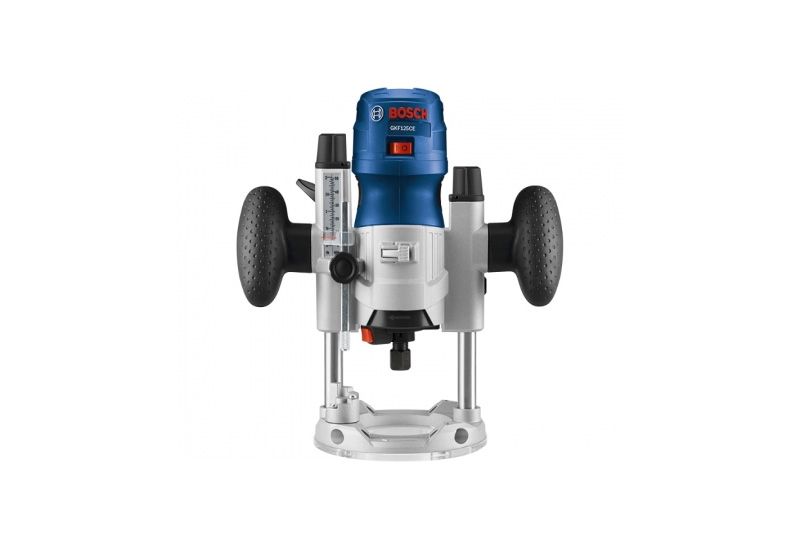
The Bosch Colt Variable-Speed Palm Router. Kit is a powerful and highly versatile tool, boasting a 1 horsepower motor and a lightweight design of just over three pounds. This router offers adjustable speed and bit depth, an LED light for improved visibility, and a straight-edge guide for precision routing. Additionally, the kit includes a hard-sided carrying case to make transport and storage easier.
The Bosch Colt Variable-Speed Palm Router. Kit is renowned for its dependability and ease of use. It has a maximum rotational speed of 35,000 RPMs, and its lightweight design makes it easy to maneuver. The adjustable speed and bit depth help users accurately control their cuts, while the LED light makes it easier to see in low-light conditions. The straight-edge guide provides improved precision and accuracy, and the hard-sided carrying case makes it easy to store and transport the router and its accessories.
Bosch PR20EVS Router Tool
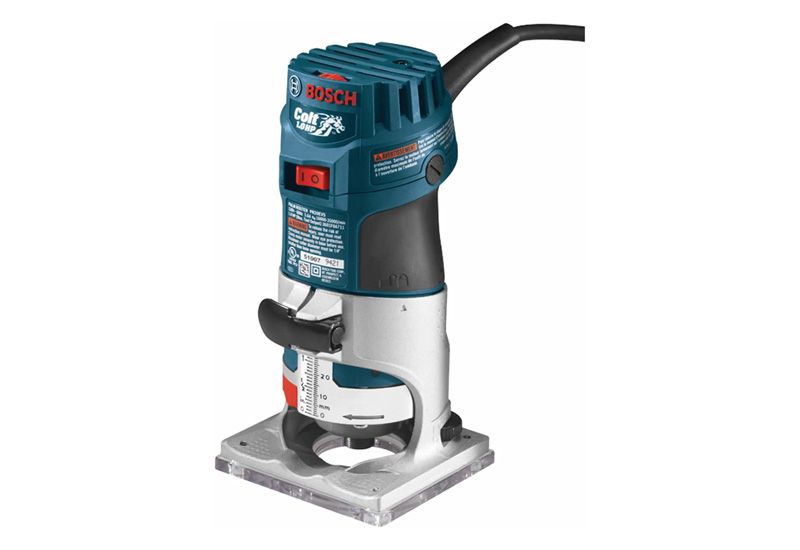
The Bosch PR20EVS Router Tool is a powerful and precise palm-grip router, designed to provide maximum performance in a compact form factor. It is equipped with a 1.0 HP, 5.6 Amp motor that offers a variable speed range of 16,000 to 35,000 RPM, making it suitable for a variety of applications. This router is highly capable and precise, and its compact size makes it easy to handle and maneuver.
The Bosch PR20EVS Router Tool is suitable for a range of projects. These include trimming laminate, cutting flutes, creating decorative edges, and creating hinge mortises. The variable speed control and the adjustable bit depth make it easier to accurately control the cutting process. Additionally, the LED light helps illuminate the work surface, making it easier to see in low-light conditions.
DeWalt 20V Max XR Cordless Palm Router

The DeWalt 20V Max XR Cordless Palm Router is a powerful and convenient cordless tool, designed to offer the same power as a corded router. It boasts a solid construction based on the DWP611 corded model, offering excellent visibility and power under load. It eliminates the need for extension cords, provides electronic brakes for enhanced safety, and has two LEDs to provide illumination of the work surface.
The DeWalt 20V Max XR Cordless Palm Router offers a number of advantages, including the convenience of cordless operation, enhanced safety with its electronic brake, and a variable speed dial and two LEDs to illuminate the work surface. Additionally, it is constructed upon the established DWP611 corded model, providing robust performance under load.
The only disadvantage of the router is that the battery is not included.
Makita RT0701C 1-1/4 HP Compact Palm Router
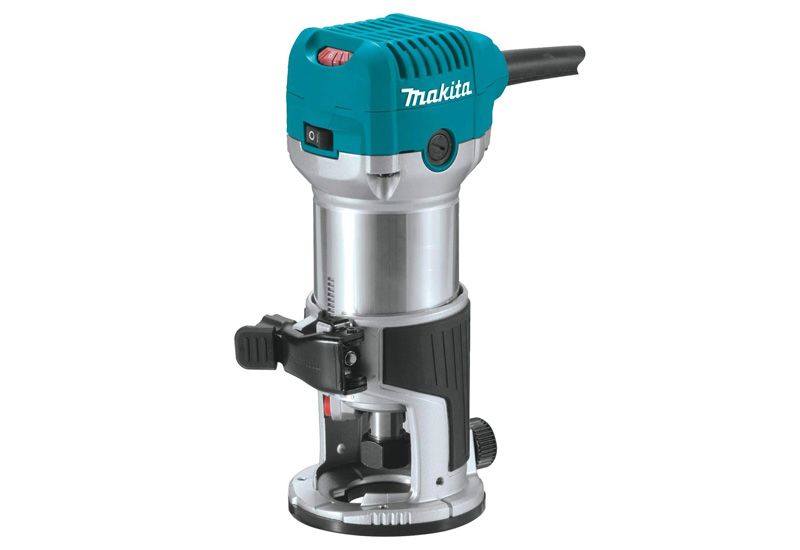
The Makita RT0701C 1-1/4 HP is the Makita RT0701C. Compact Palm Router is a powerful and versatile tool designed for woodworking applications. It is a compact hand-held router that can be used for a range of tasks. It boasts a robust construction, a broad speed range, “soft start” circuitry, and the ability to be converted into a plunge router. This makes it an ideal choice for using large diameter bits.
The “soft start” circuitry of the Makita RT0701C 1-1/4 HP Compact Palm Router provides a number of benefits, including a gradual increase in speed that extends motor life and reduces vibrations. Additionally, the wide speed range of the Makita RT0701C 1-1/4 HP Compact Palm Router makes it suitable for a range of tasks.
The Makita RT0701C 1-1/4 HP. Compact Palm Router can be converted into a plunge router by utilizing the plunge base accessory. This allows for greater control and precision when creating detailed surfaces.
Bosch 12V Max EC Brushless Palm Edge Router
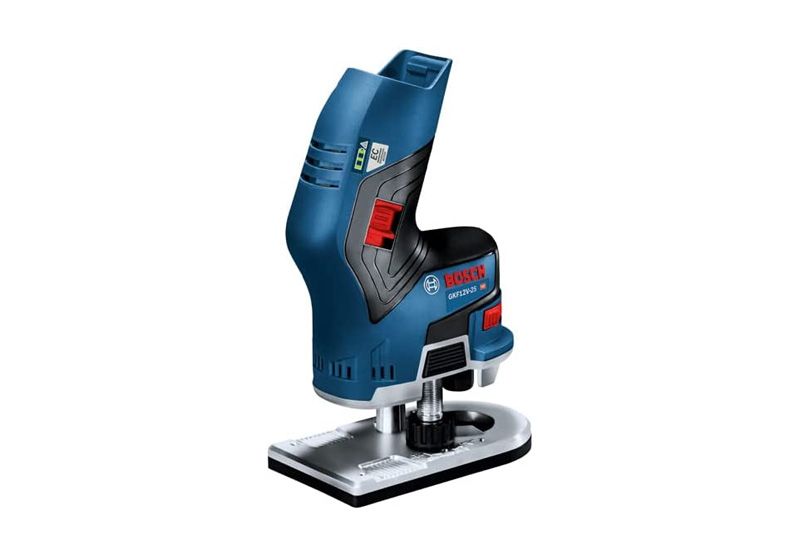
The Bosch 12V Max EC Brushless Palm Edge Router is a powerful and convenient cordless router, designed to provide efficient power and convenience for edge routing and trimming. It is ergonomically designed and features an EC Brushless motor for enhanced performance. It is equipped with a 12V Max battery, a 1/4 inch collet capacity, and a no-load speed range of 13,000 to 28,000 RPM.
This makes the Bosch 12V Max EC Brushless Palm Edge Router suitable for small to medium-sized projects, such as trimming laminate, rounding edges, and creating small cutouts. Additionally, it is lightweight and ergonomic, making it easy to maneuver and comfortable to handle.
However, it may not be suitable for larger projects. The Bosch 12V Max EC Brushless Palm Edge Router is an excellent choice for beginners and professionals alike.
Summary
Hand held routers are essential tools for professionals and hobbyists alike due to the versatility they provide in tasks such as shaping, trimming, and crafting materials. It is important to select the correct router bit based on shape, size and location of the bearing, in order to achieve the desired results. Additionally, different cutting techniques offer varying levels of control and safety; conventional milling is recommended for those who are inexperienced, while climb milling allows for better finishing and cost savings, but requires more skill.
For creating desired edge profiles, a router fence facilitates achieving a straight and consistent cut, while surface planing with a router sled is ideal for creating a flat surface. There are plenty of options available when selecting a palm router, including the highly-versatile Bosch Colt Variable-Speed Palm Router Kit, the Bosch PR20EVS Router Tool, the DeWalt 20V Max XR Cordless Palm Router, the Makita RT0701C 1-1/4 HP Compact Palm Router, the Bosch Palm Router Combination Kit, and the Bosch 12V Max EC Brushless Palm Edge Router.
Thus, whether an avid DIYer or a professional craftsman, these recommendations for hand held routers can assist in your particular project needs and budget. In conclusion, hand held routers are powerful, versatile and reliable tools no workshop should be without.